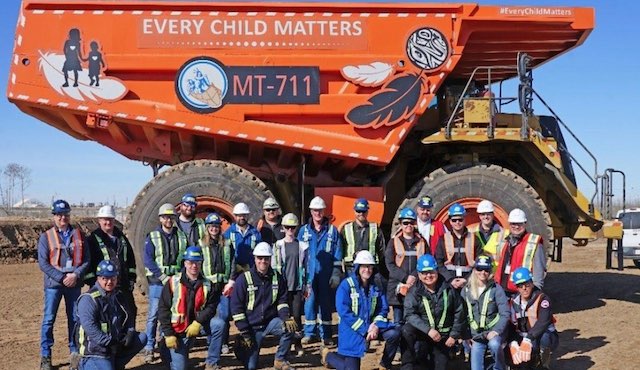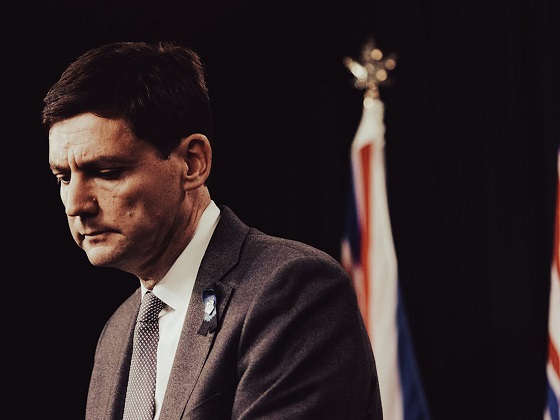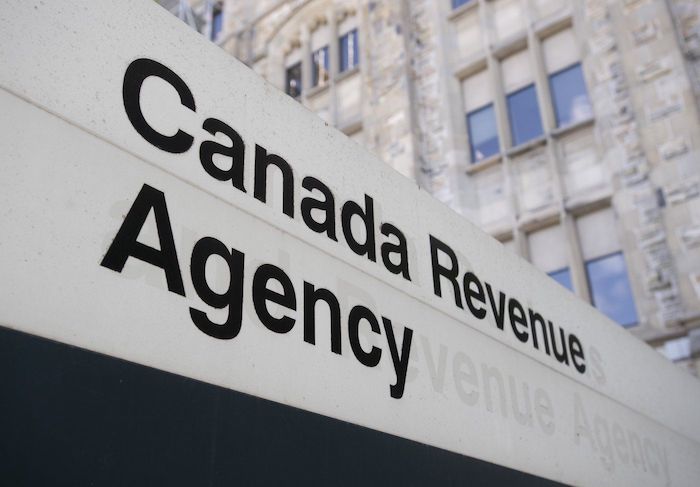Economy
“Ownership is Reconciliation” Indigenous Resource Network rebrands to emphasize shift in focus

News release submitted by the Indigenous Resource Network
Indigenous Resource Network Launches Ownership is Reconciliation
The Indigenous Resource Network (IRN) is proud to unveil its latest “Ownership is Reconciliation” Campaign, marking a transformative shift in focus and rebrand from its original “Ownership Changes Everything” campaign.
This new initiative aims to convey the compelling story of Indigenous ownership in resource projects, resonating with a diverse audience including social media, supporters, and fellow Indigenous organizations. “We initiated the ‘Ownership Changes Everything’ campaign to showcase the positive impact of Indigenous ownership in resource projects. The response has been overwhelming, with strong resonance among policy makers, industry, and Indigenous communities” shared John Desjarlais, Executive Director of IRN.
Central to the campaign’s mission is enlightening Canadians about the pivotal role Indigenous ownership plays in advancing the path to reconciliation. As part of this campaign, IRN advocates for the formation of a National Indigenous Guaranteed Loan program, empowering Indigenous communities with crucial access to capital required for equitable participation in major projects nationwide. Desjarlais elaborated, stating, “While it may not be a cure for all of the issues we see in our communities, it is an essential step in revitalizing funding opportunities for Indigenous development. We are heartened by the industry’s resounding support for a national program, as it de-risks projects and facilitates the vital capital Indigenous communities need to pursue ownership.”
IRN invites all stakeholders, Indigenous and non-Indigenous alike, to join forces in promoting a future where reconciliation and resource development harmoniously converge, generating sustainable employment opportunities and fostering shared prosperity for all.
Most Indigenous people support resource development: poll
In the polarized “environment versus economy” debate we’re having, there’s often an assumption, or an assertion, that Indigenous peoples are mostly against resource development. This is manifested in blockades, protests at legislatures and university campuses, and cries from activists that they stand in solidarity with Indigenous people when they stand against mining, oil and gas,
commercial fishing, hydro, and forestry projects.
For those familiar with the matter, this has always been a bit puzzling. Resource development is often the biggest economic driver of Indigenous communities, since it provides revenues for nations and well-paying jobs closer to home. Indigenous businesses are 40 times more likely to be involved in the extractive industry than Canadian ones.
There are absolutely cases where Indigenous nations have had disputes with resource companies, and when their rights have been disrespected. But this is not the same as being against resource development in principle. The public discussion of the issue has failed to grasp that key distinction: Indigenous peoples are not generally opposed to development; they are opposed to not being included, and they are against assuming risks without reaping any of the rewards.
To test that assumption, the Indigenous Resource Network, a platform for Indigenous workers and business owners involved in resource development, commissioned a poll by Environics Research. A total of 549 self-identified First Nations, Metis, and Inuit people living in rural areas or on reserves across Canada were interviewed by telephone between March 25 and April 16.
The poll found that a majority, 65 per cent, said they supported natural-resource development, while only 23 per cent were opposed. When asked how they’d feel if a new project were proposed near their own community, supporters outweighed opponents 2 to 1 (54 to 26 per cent). Not surprisingly, support was higher among working-age (35- to 54-year-old) respondents (70 per cent) than younger ones (18- to 34-year-olds, at 56 per cent), while Indigenous men were more likely to oppose resource development (28 per cent) than Indigenous women (19 per cent).
When asked more specifically about types of resource development, most supported both mining (59 per cent in favour versus 32 per cent opposed) and oil and gas development (53 per cent for, versus 41 per cent against). The main reason they cited was the “urgent priority” of access to health care that comes with economic development and jobs. They said other issues, such as governance, education, traditional activities, and federal transfers, were less important.
All this indicates a path toward greater social licence by Indigenous peoples to develop resources. For many respondents, their support hinges on the likely costs and benefits to them and their communities, as it does for most people. Respondents were more likely to support a project if it used best practices to: protect the environment (79 per cent), ensure safety (77 per cent), and benefit the community economically, such as by providing jobs and business opportunities (77 per cent). Interestingly, community consultation (69 per cent) and consent (62 per cent) were not as important, even though the public discourse tends to emphasize them.
Perhaps the most important finding was that the more a respondent thought he or she knew about the issue, the more he or she was likely to support resource development. Those who work in the industry or who discuss it beyond social media have a much better understanding of what’s needed for a project to get approved, the standards that must be adhered to, and the reclamation that must occur when a project is complete or decommissioned. For them, it’s more than saying yes or not to resource development; it’s about ensuring projects meet the highest possible standards.
The relationship between the resource sector and Indigenous communities isn’t perfect. But it’s economically important, and we would be well served by improving, not severing it. It’s high time we pushed the discussion about Indigenous peoples and resource development past polarizing and simplistic slogans. We hope this poll does just that. Most Indigenous peoples support resource development when high environmental standards are applied and good jobs and economic benefits follow. Let’s ensure that’s the case with every project.
Banks
Bank of Canada Cuts Rates to 2.25%, Warns of Structural Economic Damage

Governor Tiff Macklem concedes the downturn runs deeper than a business cycle, citing trade wars, weak investment, and fading population growth as permanent drags on Canada’s economy.
In an extraordinary press conference on October 29th, 2025, Bank of Canada Governor Tiff Macklem stood before reporters in Ottawa and calmly described what most Canadians have already been feeling for months: the economy is unraveling. But don’t expect him to say it in plain language. The central bank’s message was buried beneath bureaucratic doublespeak, carefully manicured forecasts, and bilingual spin. Strip that all away, and here’s what’s really going on: the Canadian economy has been gutted by a combination of political mismanagement, trade dependence, and a collapsing growth model based on mass immigration. The central bank knows it. The data proves it. And yet no one dares to say the quiet part out loud.
Start with the headline: the Bank of Canada cut interest rates by 25 basis points, bringing the policy rate down to 2.25%, its second consecutive cut and part of a 100 basis point easing campaign this year. That alone should tell you something is wrong. You don’t slash rates in a healthy economy. You do it when there’s pain. And there is. Canada’s GDP contracted by 1.6% in the second quarter of 2025. Exports are collapsing, investment is weak, and the unemployment rate is stuck at 7.1%, the highest non-pandemic level since 2016.
Macklem admitted it: “This is more than a cyclical downturn. It’s a structural adjustment. The U.S. trade conflict has diminished Canada’s economic prospects. The structural damage caused by tariffs is reducing the productive capacity of the economy.” That’s not just spin—that’s an admission of failure. A major trading nation like Canada has built its economic engine around exports, and now, thanks to years of reckless dependence on U.S. markets and zero effort to diversify, it’s all coming apart.
And don’t miss the implications of that phrase “structural adjustment.” It means the damage is permanent. Not temporary. Not fixable with a couple of rate cuts. Permanent. In fact, the Bank’s own Monetary Policy Report says that by the end of 2026, GDP will be 1.5% lower than it was forecast back in January. Half of that hit comes from a loss in potential output. The other half is just plain weak demand. And the reason that demand is weak? Because the federal government is finally dialing back the immigration faucet it’s been using for years to artificially inflate GDP growth.
The Bank doesn’t call it “propping up” GDP. But the facts are unavoidable. In its MPR, the Bank explicitly ties the coming consumption slowdown to a sharp drop in population growth: “Population growth is a key factor behind this expected slowdown, driven by government policies designed to reduce the inflow of newcomers. Population growth is assumed to slow to average 0.5% over 2026 and 2027.” That’s down from 3.3% just a year ago. So what was driving GDP all this time? People. Not productivity. Not innovation. Not exports. People.
And now that the government has finally acknowledged the political backlash of dumping half a million new residents a year into an overstretched housing market, the so-called “growth” is vanishing. It wasn’t real. It was demographic window dressing. Macklem admitted as much during the press conference when he said: “If you’ve got fewer new consumers in the economy, you’re going to get less consumption growth.” That’s about as close as a central banker gets to saying: we were faking it.
And yet despite all of this, the Bank still clings to its bureaucratic playbook. When asked whether Canada is heading into a recession, Macklem hedged: “Our outlook has growth resuming… but we expect that growth to be very modest… We could get two negative quarters. That’s not our forecast, but we can’t rule it out.” Translation: It’s already here, but we’re not going to admit it until StatsCan confirms it six months late.
Worse still, when reporters pressed him on what could lift the economy out of the ditch, he passed the buck. “Monetary policy can’t undo the damage caused by tariffs. It can’t target the hard-hit sectors. It can’t find new markets for companies. It can’t reconfigure supply chains.” So what can it do? “Mitigate spillovers,” Macklem says. That’s central banker code for “stand back and pray.”
So where’s the recovery supposed to come from? The Bank pins its hopes on a moderate rebound in exports, a bit of resilience in household consumption, and “ongoing government spending.” There it is. More public sector lifelines. More debt. More Ottawa Band-Aids.
And looming behind all of this is the elephant in the room: U.S. trade policy. The Bank explicitly warns that the situation could worsen depending on the outcome of next year’s U.S. election. The MPR highlights that tariffs are already cutting into Canadian income, raising business costs, and eliminating entire trade-dependent sectors. Governor Macklem put it plainly: “Unless something else changes, our incomes will be lower than they otherwise would have been.”
Canadians should be furious. For years, we were told everything was fine. That our economy was “resilient.” That inflation was “transitory.” That population growth would solve all our problems. Now we’re being told the economy is structurally impaired, trade-dependent to a fault, and stuck with weak per-capita growth, high unemployment, and sticky core inflation between 2.5–3%. And the people responsible for this mess? They’ve either resigned (Trudeau), failed upward (Carney), or still refuse to admit they spent a decade selling us a fantasy.
This isn’t just bad economics. It’s political malpractice.
Canada isn’t failing because of interest rates or some mysterious global volatility. It’s failing because of deliberate choices—trade dependence, mass immigration without infrastructure, and a refusal to confront reality. The central bank sees the iceberg. They’re easing the throttle. But the ship has already taken on water. And no one at the helm seems willing to turn the wheel.
So here’s the truth: The Bank of Canada just rang the alarm bell. Quietly. Cautiously. But clearly. The illusion is over. The fake growth era is ending. And the reckoning has begun.
Business
Canada heading into economic turbulence: The USMCA is finished and Canadian elbows may have started the real fight

To the average Canadian onlooker the public perception used to be that President Trump and Prime Minister Carney were getting along fabulously. All seemed to get off on the right foot with Carney and Trump. Carney giggled whenever President Trump tickled him and Canadians rested well, self-assured that Trump would completely forget about Canada the moment Carney left the room.
Unfortunately for Canadians and surprisingly to most of us, the PDA’s were only for show.
Maybe it’s the timing of Trump’s trip to ASEAN and the US trade discussions with China. Maybe it’s Trump’s reaction to Ontario’s (perhaps with the approval of Mark Carney) $75 Million taxpayer dollar attempt to upend President Trump’s entire economic strategy.
In the end it doesn’t matter. What does matter is that it appears Trump has duly received a high elbow in the corner from Premier Ford and / or Prime Minister Carney. Then, President Trump did what the producers of Canada’s most famous election ads failed to consider due to their obvious lack of ever actually having played hockey… Trump appears to have dropped his gloves and is reaching for a Red and White sweater to pull over our heads so we can’t control our arms or see what happens next.
So are we about to get pummeled? Who knows. We are a feisty little country. We used to hit well above our weight. But if we can keep with hockey analogies for a moment, it’s like Canada has begun the second period with a 2-0 lead. Hockey people know what that can mean. (Hint: It’s not elbows up).
Here’s a take from hockey… er political analysts TheLastRefuge. If you take a few minutes to read this Canada’s economic and trade situation is going to make a lot more sense. Spoiler alert: It won’t make you happy.
During the 2016 election President Trump repeatedly said he wanted to renegotiate NAFTA, the North American Free Trade Agreement. Both Canada and Mexico were reluctant to open the trade agreement to revision, but ultimately President Trump had the authority and support from an election victory to do exactly that.
In order to understand the issue, you must remember President Trump, Commerce Secretary Wilbur Ross and U.S. Trade Representative Robert Lighthizer each agreed the NAFTA agreement was fraught with problems and was best addressed by scrapping it and creating two seperate bilateral trade agreements. One between the USA and Mexico, and one between the USA and Canada.
In the decades that preceded the 2017 push to redo the trade pact, Canada had restructured their economy to: (1) align with progressive climate change; and (2) take advantage of the NAFTA loophole. The Canadian government did not want to reengage in a new trade agreement.
Canada has deindustrialized much of their manufacturing base to support the ‘environmental’ aspirations of their progressive politicians. Instead, Canada became an importer of component goods where companies then assembled those imports into finished products to enter the U.S. market without tariffs. Working with Chinese manufacturing companies, Canada exploited the NAFTA loophole.
Justin Trudeau was strongly against renegotiating NAFTA, and stated he and Chrystia Freeland would not support reopening the trade agreement. President Trump didn’t care about the position of Canada and was going forward. Trudeau said he would not support it. Trump focused on the first bilateral trade agreement with Mexico.






-

 Internet2 days ago
Internet2 days agoMusk launches Grokipedia to break Wikipedia’s information monopoly
-

 Business1 day ago
Business1 day agoCanada heading into economic turbulence: The USMCA is finished and Canadian elbows may have started the real fight
-

 Business2 days ago
Business2 days agoBill Gates walks away from the climate cult
-

 Opinion2 days ago
Opinion2 days agoBritish Columbians protest Trump while Eby brings their province to its knees
-

 National1 day ago
National1 day agoCanada’s NDP is now calling women ‘non-males’
-

 National1 day ago
National1 day agoCanadian MPs order ethics investigation into Mark Carney’s corporate interests
-

 Business1 day ago
Business1 day agoFord’s Liquor War Trades Economic Freedom For Political Theatre
-

 Banks1 day ago
Banks1 day agoBank of Canada Cuts Rates to 2.25%, Warns of Structural Economic Damage










